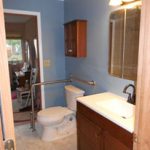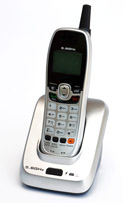How to Quickly Make Your Home Wheelchair Friendly
April 3, 2013
Making a home wheelchair friendly can be a tricky prospect, though of course the effort is certainly in service of a worthy cause. People in wheelchairs can indeed have a very difficult time navigating around a typical home, with a thousand things in their way making their journey that much more difficult. If a wheelchair-bound person is planning on moving into a new home there will likely have to be a good deal of remodeling to allow them optimal access. But what if you don’t have the time or money for major remodeling? What if, rather than living there, a handicapped person is simply visiting you for a day or two and you want to make your home temporarily easier to traverse. You’ll be glad to know that, while your home will likely still prove to be a bit of a struggle for a handicapped individual, there are some small, cost-effective measures which can be taken to make your home at least partially accessible. Here are a few of them:
- Install outdoor ramps. When a handicapped person visits a building of any kind, the first question is always how they will get inside. Therefore, your first step should be the purchase of a ramp, either long-term or temporary, which will allow your guest the ability to enter and exit your home.
- Reorganize your furniture. Most traditional furniture setups don’t allow for optimal wheelchair mobility. Make sure that you leave at least a 32 inch gap between major areas. Ideally you should try to allow for five feet of turning space.
- Remove all rugs. As aesthetically pleasing as they might be, rugs are not ideal for people in wheelchairs, as they can easily get stuck or caught on the sides. Basically, if your carpeting isn’t attached to your floor it’s simpler just to move it out of the way.
 Get at least one cordless phone. If a handicapped person is going to be staying in your home for a while, you’ll want to provide them access to a cordless phone. Of course, phones with cords are not especially common these days, what with the prevalence of cell phones, but ensuring that your friend has at least one phone they can easily access is extremely important. Allow them to keep it nearby and travel with it if they wish.
Get at least one cordless phone. If a handicapped person is going to be staying in your home for a while, you’ll want to provide them access to a cordless phone. Of course, phones with cords are not especially common these days, what with the prevalence of cell phones, but ensuring that your friend has at least one phone they can easily access is extremely important. Allow them to keep it nearby and travel with it if they wish.
- Consider installing grab bars. Though some might consider this remodeling, grab bars aren’t especially difficult to install and they’re not particularly expensive. They’re certainly something to consider, particularly in the bathroom.
- Portable ramps. Use these in conjunction with doors with high thresholds to allow for easy access to the majority of the house. Unfortunately, major flights of stairs are a more complex prospect.
- Look into stair lifts. Most of the products included on this list are fairly cheap. Stair lifts are not. In fact, you’d be hard pressed to find one for less than $1,300, and many of them are quite a bit more. Unfortunately they’re often the only viable option for even a moderately steep flight of stairs. If you have the money, consider if. If you don’t, your wheelchair-bound associate will likely not be able to get up the stairs without assistance.
- Consider altering your door handles. Again, some might feel that this comes dangerously close to remodeling, and it’s certainly a bigger financial/labor commitment than most of the items on this list. However, doorknobs can often be difficult for handicapped users to operate. If your associate is staying with you for a fairly long time, you might consider replacing them with level-type handles, which are much easier for the average wheelchair-bound person to use.
- Use non-slip pads in the bathroom. Many people who are not mobility impaired do this anyway, as its simply safer. However, if a handicapped person is to use your shower or tub, a non-slip pad or two is an absolutely essential purchase.
- Get a wand to attach to your shower head. For many handicapped users, the use of a portable wand is very important. Your associate may need to sit while they’re showering, in which case a waterproof seat would also be a necessary purchase. For these people especially, cleaning with a wand is simply easier and more effective.
- Don’t forget possible DIY options. If you cannot afford new door handles, consider tying pieces of string to your current ones, which will make them easier to close. However, unless you make the switch to levers know that opening your doors will always be a challenge for some. If you can’t afford ramps, it’s fairly easy to build a temporary one yourself using a wedge-shaped piece of wood and some glue.
Of course, when it comes to quick, temporary changes like these you won’t be able to do everything necessary to make your home handicap-accessible. For example, sinks will likely prove difficult for a w heelchair-bound user to operate without remodeling. Your kitchen will also provide challenges, as counter space will be largely inaccessible and a good deal of appliances will likely be out of reach. However, there’s only so much that can be done. If you’re looking to make your home permanently handicap-friendly, that will take more than a bit of time and money. But if you only want the changes you make to be temporary and cheap you can and should consider the options detailed above. You won’t be able to do everything that should be done, but you’ll certainly be able to do a good deal to help.
heelchair-bound user to operate without remodeling. Your kitchen will also provide challenges, as counter space will be largely inaccessible and a good deal of appliances will likely be out of reach. However, there’s only so much that can be done. If you’re looking to make your home permanently handicap-friendly, that will take more than a bit of time and money. But if you only want the changes you make to be temporary and cheap you can and should consider the options detailed above. You won’t be able to do everything that should be done, but you’ll certainly be able to do a good deal to help.
 Get at least one cordless phone. If a handicapped person is going to be staying in your home for a while, you’ll want to provide them access to a cordless phone. Of course, phones with cords are not especially common these days, what with the prevalence of cell phones, but ensuring that your friend has at least one phone they can easily access is extremely important. Allow them to keep it nearby and travel with it if they wish.
Get at least one cordless phone. If a handicapped person is going to be staying in your home for a while, you’ll want to provide them access to a cordless phone. Of course, phones with cords are not especially common these days, what with the prevalence of cell phones, but ensuring that your friend has at least one phone they can easily access is extremely important. Allow them to keep it nearby and travel with it if they wish.